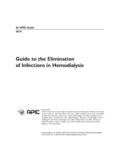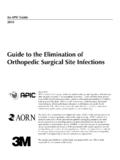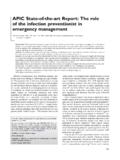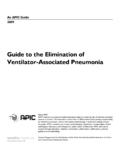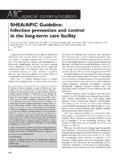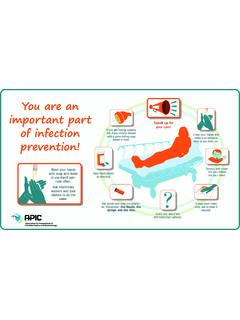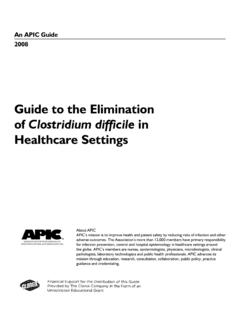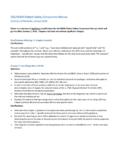Transcription of handhygiene HCW final - APIC
1 Adapted from: Boyce, J., Pittet, D, the Healthcare Infection Terms Important Hand Hygiene Tips Control Practices Advisory Committee and the HICPAC/SHEA/. apic /IDSA Hand HygieneTask Force. Guideline for Hand Hygiene in Health-Care Settings. MMWR, 2002, 51, RR-16. When washing hands, repeated use of HOT (vs Alcohol Based Handrub warm) water may increase the risk of Alcohol-containing preparations designed dermatitis. for hand application to reduce the numbers Liquid, bar leaflet or powdered soap is of viable microorganisms on the hands acceptable for handwashing with non- Infection Control & Epidemiology antimicrobial soap and water. Antimicrobial Soap Handwashing, NOT alcohol-based handrubs, Soap ( detergent) containing an antiseptic should be used to clean hands contaminated agent by bacterial spores such as Clostridiium difficile or Bacillus anthracis (Anthrax). Decontaminate Hands Choose alcohol handrubs containing To reduce bacterial counts on hands by 60-95% isopropanol, ethanol or n-propanol per performing antiseptic handrub or antiseptic CDC Hand Hygiene Guidelines.
2 Handwash Choose alcohol handrubs with 1-3% glycerol or Hand Hygiene other emollients. A general term that applies to handwashing, Alcohol-based handrubs, rinses or gels antiseptic handwash, antiseptic handrub, or containing emollients cause LESS skin irritation surgical hand antisepsis and dryness than soaps OR antimicrobial detergents tested. Persistent Activity Alcohol-based handrubs, etc., should be stored Refers to the prolonged or extended away from high temperatures, flames, electrical antimicrobial activity that prevents or inhibits outlets or oxygen receptacles, according to the growth or survival of microorganisms recommendations from the National Fire following application of the product Protection Agency (NFPA). Plain soap It is NOT necessary, or recommended, to routinely WASH hands after application of Detergents that do NOT contain antimicrobial agents or contain low concentrations of antimicrobial agents that.
3 Alcohol-based handrubs. Provide moisturizing skin care products or Hand Hygiene are effective solely as preservatives Proteinaceous . barrier creams for employee use. Ensure these products will not compromise glove barrier. Use of antimicrobial-impregnated wipes is for Healthcare Workers Any substance composed of proteins considered equivalent to handwashing, but they are not considered a substitute for alcohol Surgical Hand Antisepsis handrubs or antimicrobial soap. Antiseptic handwash or antiseptic handrub performed preoperatively by surgical personnel to eliminate transient and reduce resident flora. Antiseptic detergent preparations often have persistent This brochure was originally developed for Infection Control Week 2003, sponsored by Kimberly-Clark. antimicrobial activity Visibly Soiled Hands Special thanks to Jolynn Zeller, RN, CIC for developing the pamphlet, and to Mishga Moinuddin, MPH, CIC, Kathy Brooks, Hands showing visible dirt or that are visibly RN, PhD, CIC, Kathy Stoessel, RN, BSN, MS, and Wava Truscott, contaminiated with proteinaceous material, PhD, for reviewing and revising the pamphlet.
4 Copyright . blood, or other body fluids ( fecal 2005, by the Association of Professionals in Infection Control material or urine) and Epidemiology, Inc. ( apic ) Rev_3-10-05_SV. Background Hand Hygiene Recommendations Hand Hygiene Techniques For over 150 years, scientists have Handwashing with Plain or Antimicrobial Soap Wash Hands with Plain or Antimicrobial Soap: associated decreased morbidity and Purpose: Physical removal of soil and transient When visibly dirty mortality rates with the practice of cleaning microorganisms, including bacterial spores one's hands. Studies show that hand When contaminated with proteinaceous Wet hands with water. hygiene contributes to reductions in material Apply soap to hands, according to healthcare-associated infections. Studies When contaminated with blood or body fluids manufacturer's directions. also reveal that the greater the need to Before eating or handling food clean hands, the LESS the adherence to Rub hands vigorously together for at least After using the restroom 15 seconds.
5 Proper hand hygiene. Cover all surfaces of hands and fingers. Healthcare workers report various factors Decontaminate Hands with Alcohol Handrubs: Rinse hands well to remove soap residue. that contribute to poor compliance with When NOT visibly soiled Dry with paper towel. hand hygiene, including, but not limited to: Before direct patient contact Use towel to turn off faucet. Working in an intensive care unit Before donning sterile gloves to insert central Wearing of gloves/belief that gloves intravascular lines Hand Hygiene with Alcohol-Based Handrub eliminate the need Before inserting urinary catheters, other IV Purpose: Reduction of bacterial counts on Hand dryness or irritation catheters, OR invasive devices that do not hands when hands are NOT visibly soiled nconvenient sink location require surgical placement Apply product to palm of one hand. Lack of soap/paper towels After contact with patients' intact skin Rub hands together.
6 After contact with mucous membranes or non- Cover all surfaces of hands and fingers. intact skin if hands are not visibly soiled If hand hygiene is to improve, it is essential Rub until hands are dry. to eliminate the barriers associated with After removing gloves these factors. Barriers include: If moving from a contaminated body site to a Surgical Hand Antisepsis with Antimicrobial Soap Lack of knowledge that guidelines for clean body site during cares or Alcohol-Based Handrub hand hygiene exist After contact with objects (including equipment). Purpose: Elimination of transient located in the patient's environment Failure to recognize hand hygiene microorganisms and reduction of resident opportunities during the performance of hand flora, performed prior to surgical one's duties procedures, before donning sterile gloves Lack of awareness for the risk for cross- Remove rings, watches, bracelets before transmission of organisms beginning surgical hand scrub.
7 A Note About Fingernails Use a nail cleaner and running water to On the average, studies reveal that it takes remove debris from under fingernails. Thousands of pathogenic organisms can survive about 62 seconds to complete the cycle under and around fingernails. Clean areas under When using antimicrobial soap, scrub for at from finishing a patient task, to washing least 2-6 minutes, or as recommended by fingernails if they are visibly dirty, and pay special hands, to returning to patient care activities. the manufacturer. attention to these areas when you wash OR use Removing barriers requires efforts to make alcohol handrubs for cleaning hands. Freshly When using an alcohol-based surgical hand hand hygiene easily accessible, time applied nail polish does not increase the scrub product with persistent activity, saving, and contribute to improved skin numbers of germs present, but chipped nail prewash hands and forearms with a non- condition.
8 Use of the recommended 1-3 ml polish may harbor bacteria. Persons with artificial antimicrobial soap: alcohol handrub solution takes about 25-30 nails are more likely to harbor higher bacterial 1. Dry hands and forearms completely. seconds. You will save time using alcohol counts than those who do not wear them. For this 2. Apply alcohol-based product as handrubs! reason, healthcare personnel who work in high recommended. risk areas should not wear artificial nails. 3. Allow hands and forearms to dry completely. 4. Don sterile gloves.
